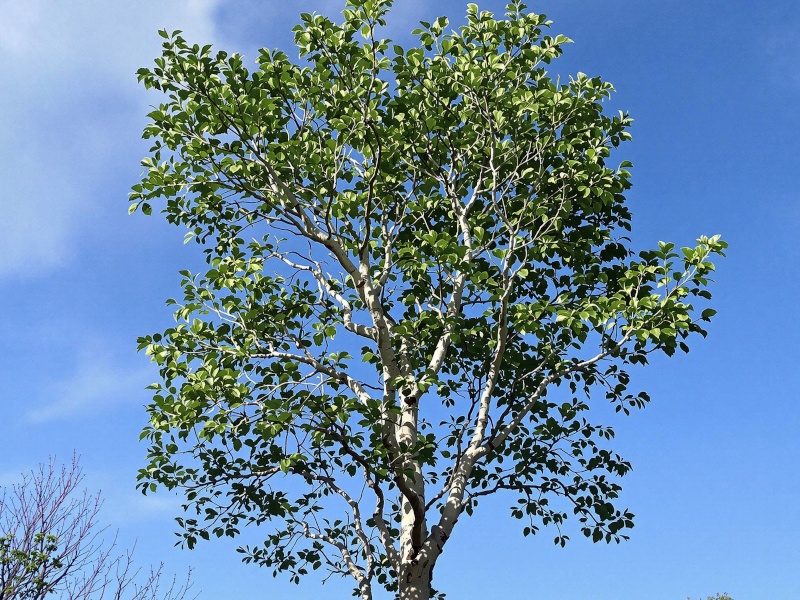Wise Mind Herbs
Evidence-based Herbal Healing
The information on this page has been prepared with reference to published scientific literature, not by a medically qualified expert. It is not medical advice. Any decision to use a supplement or herb-based product is your responsibility. Consult a suitably qualified medical professional, especially if you have underlying conditions. Remember, nothing is for everyone, and not everything sold is what it claims to be. Some things work for some people, some of the time.
Aspen / Poplar Tree
Aspen trees belong to the genus Populus, with the most common species being Populus tremula (European aspen), Populus tremuloides (quaking aspen or American aspen), and Populus grandidentata (bigtooth aspen). These trees are often confused with birch (Betula spp.) due to their similar appearance, though they belong to different botanical families. It's important to note that "white poplar" (Populus alba) is sometimes mistakenly called aspen but represents a different species within the same genus, as does black poplar.

Bioactive Compounds
Poplar trees contain several bioactive compounds, including salicylates (similar to those in willow bark), flavonoids, phenolic glycosides (particularly salicin and tremulacin), and various terpenes. The bark is particularly rich in these compounds, though leaves and buds also contain medicinal constituents.
Evidence-Based Health Benefits
Research on poplar's medicinal properties has shown several potential health benefits, though it's important to note that many traditional uses lack robust clinical validation. The following conditions have shown some evidence of benefit:
- Inflammatory conditions: The salicin content in poplar bark demonstrates anti-inflammatory properties similar to aspirin but generally with fewer gastrointestinal side effects.
- Pain management: Studies suggest effectiveness for rheumatic pain, joint pain, and general analgesic properties.
- Fever reduction: Traditional use as an antipyretic has some scientific support due to salicylate content.
- Skin conditions: Topical applications show benefits for eczema and psoriasis in preliminary studies.
- Antimicrobial properties: In vitro studies demonstrate activity against certain bacterial and fungal strains.
Conditions Without Sufficient Evidence
Despite traditional claims, current scientific literature does not provide robust evidence that poplar preparations can "cure" any specific medical condition. Claims regarding aspen's efficacy for the following conditions require further research:
- Cancer treatment
- Diabetes management
- Cardiovascular disease prevention
- Neurological disorders
- Respiratory conditions beyond basic symptom management
Recommended Dosages
Dosage guidelines vary by preparation type and are not well-standardized across studies. The most common dosage forms include:
- Dried bark: 1-2 grams three times daily, standardized to contain 8-10% salicin.
- Fluid extract (1:1): 1-2 mL three times daily.
- Tincture (1:5): 5-10 mL three times daily.
- Topical preparations: 10-15% concentration in creams or ointments.
Most clinical studies have used extracts standardized to salicin content (5-10%), though the complete phytochemical profile likely contributes to therapeutic effects.
High-Dose Studies and Knowledge Gaps
Limited research exists on high-dose aspen preparations. The few available studies suggest that doses exceeding 3 grams of dried bark equivalent daily provide no additional therapeutic benefit while increasing the risk of adverse effects. A significant knowledge gap exists regarding long-term safety and efficacy of sustained use, as most studies have been relatively short-term (2-12 weeks). Additionally, pharmacokinetic studies characterizing the absorption and metabolism of poplar compounds beyond salicin are notably lacking.
Side Effects and Contraindications
While generally well-tolerated compared to synthetic salicylates, poplar preparations can cause:
- Gastrointestinal disturbances: nausea, stomach discomfort, and diarrhea (most common).
- Allergic reactions: particularly in individuals with salicylate sensitivity or known allergy to plants in the Salicaceae family.
- Bleeding risk: increased risk of bleeding due to antiplatelet effects of salicylates.
- Drug interactions: potential interactions with anticoagulants, NSAIDs, and certain antidepressants.
Aspen preparations should be avoided in pregnancy, breastfeeding, children under 12 (due to theoretical risk of Reye's syndrome), individuals with bleeding disorders, pre-existing gastrointestinal conditions, and those scheduled for surgery within two weeks.
Conclusion
While aspen tree extracts show promising therapeutic potential, particularly for inflammatory conditions and pain management, more rigorous clinical research is needed to establish optimal dosing protocols, confirm efficacy, and fully characterize safety profiles. The traditional medicinal uses of aspen have some scientific rationale due to its salicin content and other bioactive compounds, but claims of "curing" specific conditions remain largely unsupported by current evidence.
References
Cheng, G. F., Liu, D. P., Yang, D. X., He, K. Q., Bai, J. Y., & Zhu, X. Y. (1994). Antiinflammatory effects of Tremulacin, a Salicin-related substance isolated from Populus tomentosa Carr. leaves. Phytomedicine, 1(3), 209-211.
Guleria, I., Kumari, A., Lacaille-Dubois, M. A., Nishant, Kumar, V., Saini, A. K., ... & Lal, S. (2022). A review on the genus Populus: a potential source of biologically active compounds. Phytochemistry Reviews, 1-60.
Lin, C. R., Tsai, S. H. L., Wang, C., Lee, C. L., Hung, S. W., Ting, Y. T., & Hung, Y. C. (2023). Willow bark (Salix spp.) used for pain relief in arthritis: A meta-analysis of randomized controlled trials. Life, 13(10), 2058.
Okińczyc, P., Widelski, J., Nowak, K., Radwan, S., Włodarczyk, M., Kuś, P. M., ... & Korona-Głowniak, I. (2024). Phytochemical profiles and antimicrobial activity of selected Populus spp. bud extracts. Molecules, 29(2), 437.
Pal, R. S., Pal, Y., Lalitha Chaitanya, M. V. N., Mazumder, A., Khurana, N., & Tharu, P. K. (2024). Discerning the Multi-dimensional Role of Salicin: Bioactive Glycoside Beyond Analgesic: Different Perspectives. Current Drug Therapy, 19(7), 757-764.
Shara, M., & Stohs, S. J. (2015). Efficacy and Safety of White Willow Bark (Salix alba) Extracts. Phytotherapy research : PTR, 29(8), 1112–1116. https://doi.org/10.1002/ptr.5377